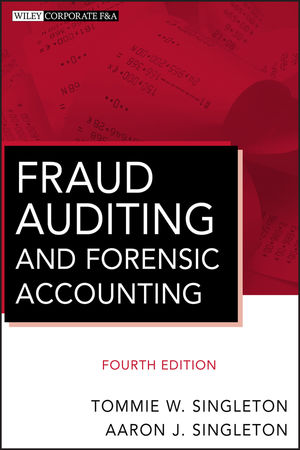Fraud Auditing and Forensic Accounting, 4th EditionISBN: 978-0-470-56413-4
Hardcover
336 pages
September 2010
 This is a Print-on-Demand title. It will be printed specifically to fill your order. Please allow an additional 10-15 days delivery time. The book is not returnable.
|
||||||
Preface xi
Acknowledgments xiii
Chapter 1: Background of Fraud Auditing and Forensic Accounting 1
Introduction 1
Brief History of Fraud and the Antifraud Profession 3
The Fraud Cycle 7
Review of Technical Literature 9
Forensic Accountant and Audits 11
Forensic Accountants 20
Fraud Auditors 25
Keys to Effective Fraud Investigation 31
The Antifraud Professional’s Career 33
Summary 36
Notes 37
Chapter 2: Fraud Principles 39
Introduction 39
Definition: What Is Fraud? 40
Synonyms: Fraud, Theft, and Embezzlement 42
Classic Fraud Research 42
Fraud Triangle 44
Scope of Fraud 47
Profile of Fraudsters 49
Who Is Victimized by Fraud Most Often? 53
Fraud Taxonomies 54
Fraud Tree 62
Evolution of a Typical Fraud 65
Summary 68
Notes 69
Chapter 3: Fraud Schemes 71
Introduction 71
ACFE Fraud Tree 73
Financial Statement Schemes 80
Corruption Schemes 83
Asset Misappropriation Schemes 84
Summary 94
Notes 94
Chapter 4: Red Flags 95
Introduction 95
Professional Standards 97
Common Red Flags 99
Specific Red Flags 101
Fraud Detection Model 110
Summary 111
Notes 112
Chapter 5: Fraud Risk Assessment 113
Introduction 113
Technical Literature and Risk Assessment 114
Risk Assessment Factors 115
Risk Assessment Best Practices 119
Risk Management Checklists and Documentation 125
Summary 129
Notes 129
Chapter 6: Fraud Prevention 131
Introduction 131
Prevention Environment 132
Perception of Detection 135
Classic Approaches 137
Other Prevention Measures 139
Accounting Cycles 141
Summary 143
Notes 143
Chapter 7: Fraud Detection 145
Introduction 145
Fraud Detection Axioms 146
Common Detection Methods 146
Specific Detection Methods 149
Summary 155
Appendix 7A: Beneish’s Ratios 156
Chapter 8: Fraud Response 157
Introduction 157
Fraud Policy 157
Fraud Response Team 160
Recovery 164
Summary 165
Notes 166
Appendix 8A: ACFE Sample Fraud Policy 167
Appendix 8B: Sample Fraud Policy Decision Matrix 172
Chapter 9: Computer Crime 175
Introduction 175
History and Evolution of Computer Crimes 176
Computer Crime Theories and Categorizations 179
Characteristics of the Computer Environment 182
Information Security (INFOSEC) 185
Profiling Internet Fraudsters 186
Summary 192
Notes 193
Chapter 10: Fraud and the Accounting Information System 195
Introduction 195
Accounting Concepts 196
Segregation of Duties 202
Accounting Information Systems 203
Key Personnel 204
Computer Hardware 208
Computer Software 210
New Forms of Media 211
Audit Trail Concept 211
Summary 212
Chapter 11: Gathering Evidence 213
Introduction 213
Rules of Evidence 213
Hearsay Exceptions 217
Other Rules of Evidence 218
Summary 223
Notes 223
Chapter 12: Cyber Forensics 225
Introduction 225
Expectation of Privacy 226
Types of Investigations 227
Sources of Digital Data 230
Types of Cyber Data 231
Cyber Forensics Investigation Process 234
Variety of Specialists in Cyber Forensics 236
Summary 237
Notes 237
Chapter 13: Obtaining and Evaluating Nonfinancial Evidence in a Fraud Examination 239
Introduction 239
Interviews 240
Body Language 242
Deception Cues 243
Eye Language 244
Statement Analysis 245
SCAN 246
Summary 247
Notes 247
Chapter 14: General Criteria and Standards for Establishing an Expert Witness’s Qualifications 249
Introduction 249
Credentials 250
Personal Qualities of the Expert 255
Sources for Locating Expert Witnesses 259
Distinguishing the Actual Area of Competence 261
Summary 261
Notes 262
Chapter 15: The Legal Role and Qualifications of an Expert Witness 263
Introduction 263
Role of a Forensic Accountant as a Witness in Court 264
Legal Qualifications for a Forensic Accountant as an Expert Witness 269
Qualification and Admissibility of Accounting Evidence 270
Expert’s Role in the Litigation Team 272
Pretestimony Activities 272
Summary 273
Notes 274
Appendix 15A: Transcript of Typical Court Testimony of Expert Witness 275
Chapter 16: Effective Tactics and Procedures for the Expert Witness in Court 277
Introduction 277
Effective Profile 278
Being a Credible Expert Witness 278
Expert’s Role in the Litigation Team 279
Pretestimony Activities 280
Trial and Testimony 281
Survival Techniques 288
Summary 290
Notes 290
Chapter 17: Fraud and the Public Accounting Profession 291
Introduction 291
History of Fraud and the Auditor: A Summary 291
Fraud and the Auditor’s Liability 302
Fraud and the Auditor’s Responsibility 303
Fraud and the Auditor’s Role 306
Summary 308
Note 308
About the Authors 311
Index 313



